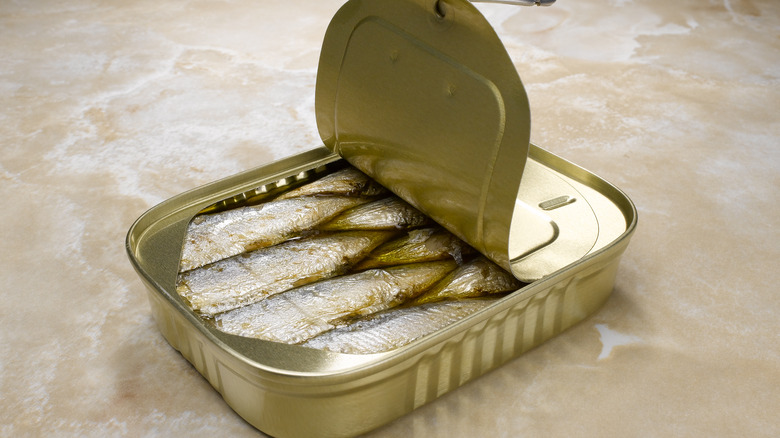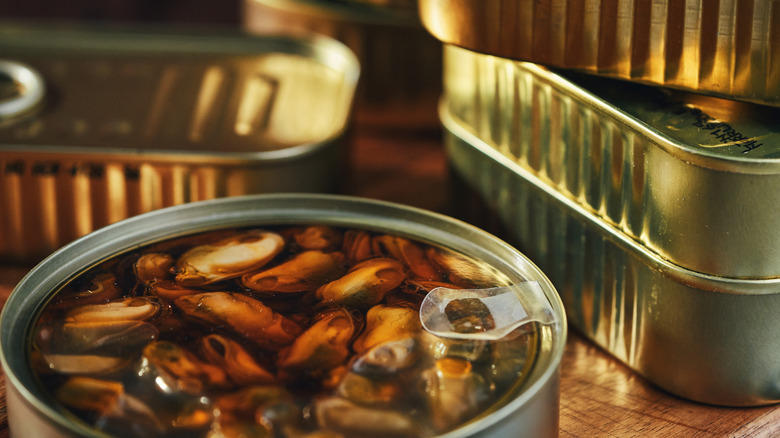When It Comes To Canned Fish, Price Doesn't Always Reflect Quality
Long seen as a choice of economy food due to it being cheaper than fresh seafood, canned fish has had a revival in recent years. Canned fish of various sorts, including sardines, tuna, and salmon, have become the sudden "it" food. Thanks to the rise of TikTok trends and general popularity online, canned fish were flying off the shelves in 2023. Cue the increase in companies offering higher-priced luxury canned seafood, and the entire concept of tinned fish as budget produce has been flipped on its head. For instance, one company is selling canned sardines specked with gold leaf for $44, promising decadence in a can.
However, when it comes to price, is it always worth paying more? Are these higher-end tinned fish offering you more for your dollar? Unfortunately, when it comes to canned fish and other seafood, price doesn't always reflect quality. While there are cases where the price does reflect a better product, you should resist the urge to grab the most expensive can on the shelves. As one shopper on Reddit put it, "Much like with bourbon, a difference is clear between a 20-dollar bottle and an 80-dollar bottle, but not much of a difference between 80 and 200+. Same for tins."
Likewise, a higher price point doesn't ensure that your canned fish was prepared or packaged right. It's better to do your research first and make an informed decision.
When price does equal quality
Just because you shouldn't blindly buy the most expensive can of fish doesn't mean you should do the opposite and load up on the cheapest tins of seafood instead. Some companies sell canned fish with high traces of mercury, posing potential health risks, especially for pregnant women. What's more, the oceans' sustainability and preservation is a major dilemma for the canned seafood industry. There are canned fish options that carry a slightly higher price tag readily available on shelves, which offer both a higher quality of fish and are sustainable.
In particular, Spain, France, and Portugal have a long history of canning seafood, with some canning companies approaching it from an artisanal lens. In Spain, the art of canning fish is a family trade for some, with the fish being organized in a can by hand rather than by machine. This is to prevent the fish from breaking apart, which is often the case if it is done by machine. Likewise, these canned fish are cooked in charcoal before being canned rather than being cooked in the tin affecting the flavor, as is a common industry practice. Finally, these higher-quality cans of seafood are packaged with olive oil instead of cottonseed oil. The olive oil enhances the flavors of the fish, making for a more enjoyable eating experience.
Why canned fish is so popular
If finding canned fish soon becomes a challenge at your local grocery store, then you can blame the new interest in the canned delicacy in the past few years. Likewise, demand for tinned seafood could potentially drive up prices — a certain irony for what is considered economical food in the United States. According to The Guardian, sales for canned fish have almost doubled in recent years, with premium brands responsible for much of this uptick. That would explain the rise of luxury brands of tinned fish. Canned seafood has even started popping up on menus across the country and is served at wine bars.
So why the sudden interest in canned seafood? Well, tinned fish has always held an appreciation in countries like Spain or France. However, the transformation from economy food to trending cuisine in the United States can be attributed to several factors. For one, the 2020 pandemic and lockdowns made many Americans develop a new appreciation for canned foods, seafood included. Likewise, the economy may have been a factor, too, with the rise in interest coming as the result of an economic downturn. Of course, social media plays a key role, with everyone wanting to jump on a trend, as TikTok proved with the tinned fish "hot girl food" craze.


